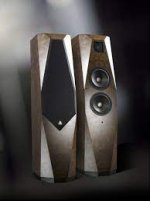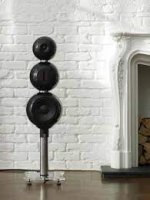I used IKEA Blanda bowls too, in 2018, with aperiodic vent and SEAS MR18 coaxial. Halves glued together with silicone. Sealed bass box as the stand.
https://www.diyaudio.com/community/threads/seas-mr18-3-way.322839/
A ball has very strong standing waves, because diameter is same in every direction. In case of IKEA Blanda approx. 600Hz is first mode. Stuffing in the middle of the ball helps a little.
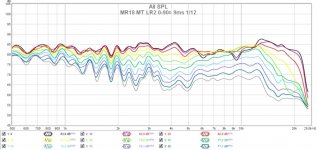
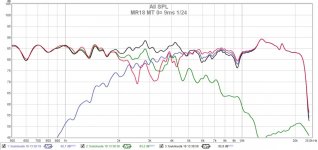
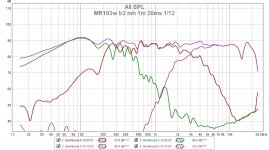
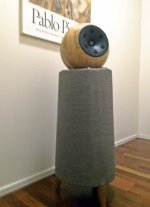
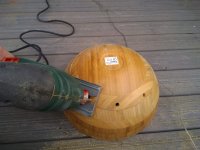
https://www.diyaudio.com/community/threads/seas-mr18-3-way.322839/
A ball has very strong standing waves, because diameter is same in every direction. In case of IKEA Blanda approx. 600Hz is first mode. Stuffing in the middle of the ball helps a little.





Last edited:
A ball is not necessarily problematic because of the same distance all around for a standing wave. The inner shape does not have to follow the outer shape, it can be anything.
^Yes, the motor of a cone driver might be near the mid of the ball and break waves. Anyway, it is the worst internal shape one can have. If the inside of the ball has golden ratio dimensions, it will have very small volume.
My spherical speakers are now at my daughter's apartment, so I can't take more measurements, eg. with the mic inside or nearfield of the cone.
My spherical speakers are now at my daughter's apartment, so I can't take more measurements, eg. with the mic inside or nearfield of the cone.
I used IKEA Blanda bowls too, in 2018, with aperiodic vent and SEAS MR18 coaxial. Halves glued together with silicone. Sealed bass box as the stand.
https://www.diyaudio.com/community/threads/seas-mr18-3-way.322839/
A ball has very strong standing waves, because diameter is same in every direction. In case of IKEA Blanda approx. 600Hz is first mode. Stuffing in the middle of the ball helps a little.
View attachment 1098066View attachment 1098067View attachment 1098072View attachment 1098068View attachment 1098076
Wow never thought of a bowl. Genius. That's an awesome driver too. Graphs liook pretty good for a frickin bowl design. I'm impressed. They should have practically no bounds reflections . No baffle step, x-over ,or phase delay issues. I am totally into single driver systems for most home applications. Just splurge on a great driver like you did. Great choice!^Yes, the motor of a cone driver might be near the mid of the ball and break waves. Anyway, it is the worst internal shape one can have. If the inside of the ball has golden ratio dimensions, it will have very small volume.
My spherical speakers are now at my daughter's apartment, so I can't take more measurements, eg. with the mic inside or nearfield of the cone.
There is a whole thread on people’s Blanda Bowl spheres.
I designed these for a fellow in Spain.

dave
I designed these for a fellow in Spain.

dave
Last edited:
Wow Dave, You knowledge is really far reaching. Imagine you extend your interests to other dimensions. I'm personally into astro physics at an amature level as well as congecture about quire quantum mechanics as any ones explainatio
Good to know I have like minded humans to relate to. I can over stretch what others think is insane. Don't know and don't want to know
Last edited by a moderator:
It is easy to place a small object inside the sphere and off center to prevent any issue.Focal, Eclipse, Mach 17.
Standing waves are inside, a sphere has the worst, in the miniOnkens the tapered enclosure has a tiny bit of spread/help but the prime purpose is dealing with outside air flow.
dave
In building speakers with 2 or more spheres, join in the middle with a pole inside, and that with the right damping takes care of any standing wave resonances. Remember a sphere is the strongest structure and to resonate it must pulsate in and out, and that is very hard to have happen.I used IKEA Blanda bowls too, in 2018, with aperiodic vent and SEAS MR18 coaxial. Halves glued together with silicone. Sealed bass box as the stand.
https://www.diyaudio.com/community/threads/seas-mr18-3-way.322839/
A ball has very strong standing waves, because diameter is same in every direction. In case of IKEA Blanda approx. 600Hz is first mode. Stuffing in the middle of the ball helps a little.
View attachment 1098066View attachment 1098067View attachment 1098072View attachment 1098068View attachment 1098076
How about damping material? Broadly speaking, different shapes for the same volume will still have standing waves. In this case you have the driver at the edge, which is interesting.It is easy to place a small object inside the sphere and off center to prevent any issue.
The boundaries between pressure areas are opportunities to damp.
A ball is strongest structure yes, it will not pulsate - no "box" resonances. But, the driver's membrane will react to the internal pressure of standing waves! Lowest mode is always strongest, and easiest to kill. Multiples are countless but much weaker. A 2-way driver's woofer also doesn't excite hgher modes much because of lowpass xo. So, focus on attenuating the first mode!
I don't have my Blanda speakers at home any more, so please someone else perhaps can measure impedance of the driver and put a mic inside the ball !
I haven't saved a measurement of my ball's vent, but I remember measuring it and the effect of stuffing. In my case the motor of the driver is smack dab in the middle of the ball fortunately. The vent is on the bottom of the backside ball, ¤6cm, and I made it right away, without any tests of a closed ball -because my speaker was inspired by Gradient 1.4 introduced in 2018. And I remember having read of these other spherical/Blanda speakers at diyaudio.com earlier
Here is semi-nearfield measurement of on-axis response of the mid with without eq or xo.
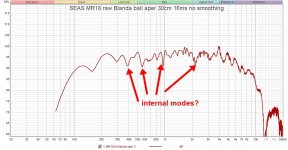
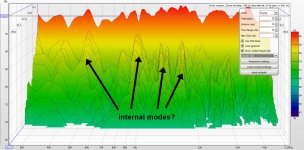
I don't have my Blanda speakers at home any more, so please someone else perhaps can measure impedance of the driver and put a mic inside the ball !
I haven't saved a measurement of my ball's vent, but I remember measuring it and the effect of stuffing. In my case the motor of the driver is smack dab in the middle of the ball fortunately. The vent is on the bottom of the backside ball, ¤6cm, and I made it right away, without any tests of a closed ball -because my speaker was inspired by Gradient 1.4 introduced in 2018. And I remember having read of these other spherical/Blanda speakers at diyaudio.com earlier
Here is semi-nearfield measurement of on-axis response of the mid with without eq or xo.


Thanks for great explaination on standing wavesIt is easy to place a small object inside the sphere and off center to prevent any issue.
I have used a 3-part damping system in my spheres, including cement-based paint on the inside of the spheres to increase density, a layer of dense carpet underlay glued on top of that, and then generous fiberglass stuffing.How about damping material? Broadly speaking, different shapes for the same volume will still have standing waves. In this case you have the driver at the edge, which is interesting.
View attachment 1098230
The boundaries between pressure areas are opportunities to damp.
Pic of damping...I have used a 3-part damping system in my spheres, including cement-based paint on the inside of the spheres to increase density, a layer of dense carpet underlay glued on top of that, and then generous fiberglass stuffing.
Attachments
Admire your experimentalPic of damping...
Admire your experimental approach. Some many variables to consider in audio you have to often think outside the proverbial box. Dave seems to have the physics nailed down on internal wave reduction. Posted some great pictures too on multiple small sound wave capturing black holes. No reflections in a black hole that any one has actually heardPic of damping...
Speakers with multiple spheres are not easy to build but they're fun to figure out, and after thousands and thousands of "box" designs over the past 60+ years (from the early ARs, KLHs, etc. - I grew up in Cambridge and lots of audio stores to visit back then) - and taking into account Olsen's work - why not make something "not box" where say maybe only a few hundred designs have been built, and far less actually brought to market. The Beomaster 3000s from the early 70s might have been the first? When I first saw them in an audio store, for me it was "wow that's different, and cool".
To me, in addition to the diffraction aspects, the vast majority of non-sphere speakers have panels that have to be joined somehow, whether these are flat or curved, odd shaped, etc. Individual panels then each can potentially vibrate in some fashion, thus the need for dense materials, bracing and internal damping. Maybe classify these as "multi-panel" enclosures (the exception being an infinite baffle design). Spheres don't have the "multi-panel" issue. And with the proper internal treatment, standing waves won't be an issue.
Simple boxes (usually rectangular) were used in the old days (like AR 3a, KLH 6, etc.) because they were easy to build. Many interesting evolutions of these of course in recent years to some very curvy and odd-shaped and other non-traditional geometric designs, and some of the higher-end ones seem to be as much art as audio. Artwork with drivers and crossovers inside. But these can be very expensive to make, even more so than spheres.
Attached a pic of an Avalon and an Envy 3 - some folks will like the curvy panel designs, I like the simplicity of spheres (which can accommodate all sorts of different drivers).
To me, in addition to the diffraction aspects, the vast majority of non-sphere speakers have panels that have to be joined somehow, whether these are flat or curved, odd shaped, etc. Individual panels then each can potentially vibrate in some fashion, thus the need for dense materials, bracing and internal damping. Maybe classify these as "multi-panel" enclosures (the exception being an infinite baffle design). Spheres don't have the "multi-panel" issue. And with the proper internal treatment, standing waves won't be an issue.
Simple boxes (usually rectangular) were used in the old days (like AR 3a, KLH 6, etc.) because they were easy to build. Many interesting evolutions of these of course in recent years to some very curvy and odd-shaped and other non-traditional geometric designs, and some of the higher-end ones seem to be as much art as audio. Artwork with drivers and crossovers inside. But these can be very expensive to make, even more so than spheres.
Attached a pic of an Avalon and an Envy 3 - some folks will like the curvy panel designs, I like the simplicity of spheres (which can accommodate all sorts of different drivers).
Attachments
Hi Dave,I designed these for a fellow in Spain.
yesterday I was at Ikea and saw the Blanda (the big one, not the small one you used for this design), then I saw the Gronsaker that has the same diameter of 28 cm and, together, they create a drop-like shaped cabinet that I remember you wrote is one of the best shapes.
What speaker and with which configuration would be the best for this cabinet?
They will be most probably on a desk, because the livingroom will have the Silbury with MA10.3 and another room the FHXL with MA11ms.
- Home
- Loudspeakers
- Multi-Way
- How to build a spherical speaker?

